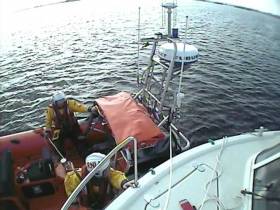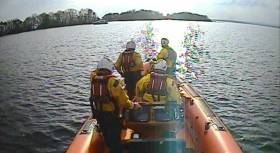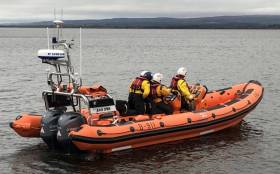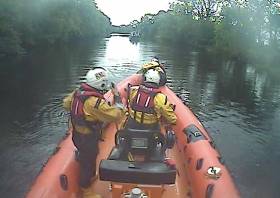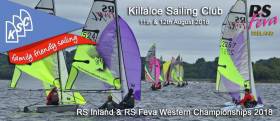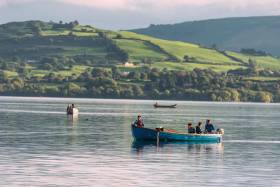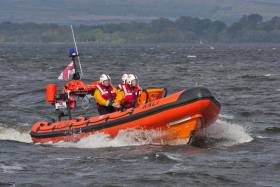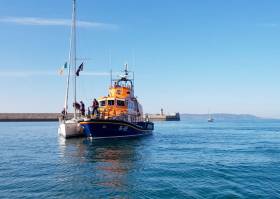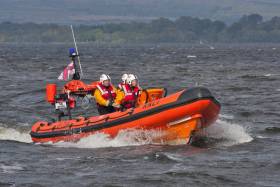Displaying items by tag: Lough Derg
Lough Derg RNLI Launch to 60-ft Vessel Aground in Coose Bay
At 3:40pm Thursday 18th April, Lough Derg RNLI was requested by Valentia Coast Guard to assist 7 people on a 60-ft cruiser aground in Coose Bay, between Split Rock and Hagen Rock.
Volunteer crew, with helm Eleanor Hooker, Owen Cavanagh, Keith Brennan and Doireann Kennedy arrived on scene and assessed the situation. Two experienced marine engineers Fergal Kearney and Will Ellis were also at the scene.
Visibility was good, with easterly winds, force 2/3.
The lifeboat took soundings of depth as it approached the casualty vessel which was aground on an extremely hazardous shoal. All passengers were wearing their lifejackets and were found to be well and unharmed. Two RNLI volunteers and Mr Kearney transferred to the cruiser and checked for ingress of water, found none but established that there was significant damage to the rudder.
Lifeboat crew set up for tow and eased the cruiser off the rocks and into safe water. The tow was passed to the rescue vessel from the cruiser company. An RNLI crew member remained with the casualty vessel until they were satisfied that the handover was complete.
The lifeboat returned to the Station and was ready for service at 6 pm.
Volunteer helm, Eleanor Hooker advises boat users ‘to remain with the navigation marks, and to ask locals about hazards before setting out from harbour’.
Lough Derg RNLI was requested by Valentia Coast Guard to assist four people, three adults and a child on a 35ft cruiser aground behind the Corrakeen Islands in Dromineer Bay yesterday.
The lifeboat was launched at 5.39pm with helm Eleanor Hooker, Dom Sharkey, Owen Cavanagh and Joe O’Sullivan on board. Winds were easterly, force 2 and visibility was good.
The crew arrived on scene within three minutes. The crew took soundings of depths as they approached the casualty vessel. An RNLI volunteer transferred to the cruiser and established that all passengers were safe and unharmed. He requested them to put on their lifejackets.
Once the lifeboat volunteer was satisfied that the cruiser was not holed, he set up for the tow. The lifeboat then took the cruiser off the rocks and into safe water, where its drives and steering were checked, and found to be undamaged.
With two volunteers on the cruiser with her passengers, the lifeboat accompanied them to Dromineer Harbour where the vessel was safely tied up alongside at 6.20pm.
The lifeboat returned to the station as was ready for service at 7 pm.
Volunteer helm Eleanor Hooker advises boat users to ‘remain within the navigation marks, and to ask locals about hazards before setting out from harbour’.
Lough Derg RNLI’s Atlantic 85 Inshore Lifeboat Jean Spier Officially Goes on Service
A new Atlantic 85 inshore lifeboat has officially gone on service at Lough Derg RNLI. The volunteer crew at Lough Derg have had intensive training over recent months in preparation for the new lifeboat Jean Spier to be officially declared a search and rescue asset.
The lifeboat will now replace Elsinore, the station’s outgoing Atlantic 75 lifeboat which while on service on Lough Derg since November 2015, launched 51 times with her crews coming to the aid of 163 people.
Fast, manoeuvrable and reliable, the Atlantic 85 operates in rough weather conditions, capable in daylight up to force seven and at night, to force six winds.
The new lifeboat, an Atlantic 85 is the latest version of the B class, introduced into the fleet in 2005. The lifeboat is 8.5 metres in length and weighs 1.9 tonnes. Improvements on its predecessor include a faster top speed of 35 knots, radar, provision for a fourth crew member and more space for casualties.
She is powered by two 115 horsepower engines and has a stronger hull and greater top speed than her predecessor. The added radar allows the crew to operate more effectively in poor visibility and she also has VHF direction-finding equipment.
The vessel also has a manually operated self-righting mechanism which combined with inversion-proofed engines keep the lifeboat operational even after capsize. The lifeboat can also be beached in an emergency without causing damage to its engines or steering gear.
The Atlantic 85 carries a full suite of communication and electronic navigation aids, as well as a searchlight, night-vision equipment and flares for night-time operations.
The new lifeboat was donated to the RNLI by Robert Spier and his late wife Jean Spier. In 2016, Robert and Jean who were active supporters of the RNLI, intended that together they would donate a new lifeboat to the charity, and were delighted when the Atlantic 85 became available to support. Sadly, Jean died in October 2017. The new lifeboat is named Jean Spier in her honour.
Speaking following the new lifeboat going on service, Liam Moloney, Lough Derg RNLI Lifeboat Operations Manager said: ‘We are delighted following the excitement of our lifeboat arriving and now after months of preparation and intensive training by our committed volunteer crew, that our lifeboat is officially on service.
‘While we had an excellent search and rescue asset in the Atlantic 75 lifeboat, the 85 has the improvements of four stroke engines, radar, room for four crew and an extra metre of length. We are confident this will be a great resource on the lake and appreciate the RNLI's investment in our lifeboat station.
‘The crew would like to express a special thanks to Helena Duggan, the RNLI’s Trainer Assessor and her training colleagues for their continued dedicated support and specialist guidance over the last few months in preparation for the lifeboat to go live.’
Niamh McCutcheon, Lough Derg RNLI Fundraising Chair added: ‘I welcome the arrival of the Atlantic 85 kindly donated in memory of the late Jean Spier to Lough Derg.’
Busy Sunday For RNLI Lifeboats At Lough Derg, Baltimore & Portaferry
#RNLI - Lough Derg RNLI assisted four people after their boat ran aground when they took a wrong turn above Victoria Lock on the River Shannon yesterday (Sunday 9 September)
Water levels at the casualty vessel’s location were very low when the lifeboat arrived at 2.11pm, a little over an hour after launch.
All four on board the casualty boat were safe and unharmed. The skipper had dropped anchor as there was a strong flow, combined with wind, at the location.
While the vessel had sustained damage to its propellers and drive, its hull was not holed.
The lifeboat took the casualty vessel under tow back to the main navigation channel and onwards to Shamrock Marina at Banagher, the closest safe harbour and where the vessel had a mooring at which it was safely tied alongside at 4pm.
Peter Kennedy, deputy launching authority at Lough Derg Lifeboat Station, advises boat owners to carry up-to-date charts and to familiarise themselves with the buoyage on the Shannon.
Meanwhile, Baltimore RNLI launched their inshore lifeboat around 2.50pm to a sailing sloop that had filled with water near the West Cork harbour.
Within three minutes the inshore lifeboat reached the casualty boat, a 6m sailing vessel with two on board which had been caught up on pot buoys and knocked over by a strong gust.
Another RIB with a Baltimore lifeboat crew member was an ready on standby as the sailors bailed out their vessel, and after helping to speed up the process, they soon had the boat clear of water and ready to sail back to Baltimore Harbour unassisted.
Much earlier on Sunday, Portaferry RNLI were part of the multi-agency response to a Mayday call from a lone sailor on a 20m act grounded at Phennick Point near Ardglass in Co Down.
Due to the vessel’s position on dangerous rocks and with fishing gear in the area, only Portaferry’s inshore lifeboat was small enough to manoeuvre through the rocks and rough seas to retrieve the sailor and transfer him safety to Ardglass Marina.
RS Inlands Start Today In Killaloe
#RS - Killaloe Sailing Club is hosting the RS Inland and RS Feva Western Championships this weekend, starting today Saturday 11 August.
The RS sailing community will be out in force on Lough Derg for the weekend, with full camping facilities available at the club and a barbecue set for this evening at 6.30pm.
For more details on the event see the RS Ireland website HERE.
World Canals Conference Looks To China For Inspiration
#WCC - Zhu Minyang completes the list of keynote speakers at the upcoming World Canals Conference in Athlone next month.
Zhu has been the chair of the World Historical and Cultural Canal Cities Cooperation Organization (WCCO) since 2012, and has also served as party secretary of the city of Jiangyin and as mayor of Yangzhou, the ‘first city of the Grand Canal’.
Zhu personally participated in the selection of China’s Beijing–Hangzhou Grand Canal for the World Heritage List in 2014. He has extensive insights and experience in the development of Chinese social organisations and contemporary social governance.
Through his leadership, the WCCO has become a platform for economic and cultural exchanges focused on the world’s canal cities.
Zhu will address the conference on how the WCCO is supporting the renovation of China’s most famous canal. Through economic and ecological restoration and investment in heritage and cultural research, it is intended that a “human community with shared destiny” will develop to create deeper co-operation and regeneration opportunities for China’s canals.
Zhu Minyang will address the conference under its first theme, ‘Restore’, which calls for reflection on how 200-year-old man-made navigations remain relevant for people today.
Over the course of the conference, a variety of speakers from across Europe, Canada and the US will detail restoration works along their waterways as well as how they ensure that no heritage value is lost in these restorations.
John McKeown will speak on restoring the Royal Canal, Roger Squires will cover new approaches to restoration, while Pam Veinotte discusses evolving heritage assets to meet modern-day needs.
Restoration of the Shannon–Erne Waterway is the subject of Joseph Gillespie’s talk, while
Rudy Van der Ween talks the re-opening of the Lower Scheldt in the city centre of Ghent in Belgium, and Rob Vrojliks puts the focus on Limburg in the Netherlands and its regional masterplan approach.
From the US, William Holdsworth will explain how the Chesapeake & Ohio Canal Aqueduct restoration at Williamsport, Maryland brings history alive, while Theron Robson talks maintenance of heritage lock gates on the River Shannon, and Roger Alsater assays preservation efforts for the Göta Canal in Sweden.
‘Regenerate’ (focused on water management challenges) and ‘Reimagine’ (on engaging a wider audience with their local waterways) are the other two tracks at the World Canals Conference which begins in 37 days’ time. Details can be found on the World Canals Conference website.
President Michael D Higgins To Speak At World Canals Conference In Athlone This September
#InlandWaters - President of Ireland Michael D Higgins has been confirmed as a guest of honour at the World Canals Conference in Athlone this autumn.
“We are honoured that the President who throughout his career has demonstrated his commitment to and love of the inland waterways of Ireland, their history and culture, has agreed to speak at the conference and we look forward to hearing how he perceives the restoration, regeneration and reimagining of the waterways,” organisers said.
There are 53 days and counting till the three-day conference from 10-12 September at the Radisson Blu Hotel Athlone under the theme ‘restoring, regenerating, re-imagining’ — with various tours and sessions designed to inspire and connect delegates coming to the Midlands from all around the world.
These tours include an excursion around Lough Derg, the largest and most southerly lake on the River Shannon, that takes in the 1700s bridge linking Killable and Ballina as well as the Ardnacrusha hydroelectric plant, and will explore the challenges of doubling moorings along an old navigation.
Another technical tour will explore the North Shannon, Lough Allen Canal and the Shannon-Erne Waterway, with a stop at the Acres Lake floating boardwalk and a look at the marriage of modern and traditional locks at Kilclare.
As previously reported on Afloat.ie, the conference will be preceded by the three-day Shannon Athlone Feastival, highlighting local food producers in an exciting festival atmosphere with rowing, raft racing, a Viking village and demonstrations of flyboarding that wowed the crowds at the recent SeaFest in Galway.
Special rates for accommodation on board luxury cruise liners are still available, as are a range of exhibition opportunities for organisations looking to network with delegates. Details can be found on the World Canals Conference website.
#RNLI - Lough Derg RNLI launched to assist two adults on a 30ft cruiser with electrical failure deep in Youghal Bay off Garrykennedy yesterday afternoon, Monday 16 July.
Valentia Coast Guard requested the lifeboat to launch at 2pm to the casualty vessel, which was reported to be on the eastern shore of Lough Derg.
Winds were westerly Force 4 and gusting 5 with frequent heavy squalls, but visibility was good.
The lifeboat launched at 2.10pm with helm Eleanor Hooker, Ger Egan and Edel Knight on board. The casualty vessel was located 10 minutes later and both adults on board were found to be safe and unharmed, wearing their lifejackets, having dropped anchor to prevent drift.
One of RNLI volunteers, a marine engineer, found that the vessel had an electrical fault and prepared the cruiser for tow to Garrykennedy Harbour, where it was safely tied alongside by 3.10pm.
Volunteer helm Ger Egan said: “Given the changeable conditions on the lake today, the skipper did the correct thing to drop anchor and immediately call for help.”
#RNLI - Dun Laoghaire RNLI responded to a yacht with one man onboard on Saturday afternoon (30 June) when the skipper’s engine failed just outside Bray Head.
The volunteer lifeboat crew were called into action at 16.24pm following a report from the Irish Coast Guard.
The yacht was on passage from Arklow when engine trouble flared just outside Bray Head.
As the country is experiencing a heatwave, weather conditions were near perfect with clear blue skies and good visibility.
The lifeboat crew quickly arrived on scene and successfully towed the yacht and skipper, who was uninjured, safely back to Dun Laoghaire Harbour.
Commenting after the callout, Dun Laoghaire RNLI coxswain Kieran Colley said: “The skipper of the vessel indeed made a good decision in calling for assistance. He was also wearing a lifejacket, which I’m always glad to see. I can’t stress enough how important it is to wear one.”
Later that same day, Lough Derg RNLI launched to assist a family of five on a 25ft cruiser with engine failure in Youghal Bay, off Garrykennedy on the eastern shore of Lough Derg.
Winds were northerly Force 1/2 and visibility was very good when the lifeboat launched at 6.47pm, arriving on scene just four minutes later.
The lifeboat crew — helm Eleanor Hooker, Dom Sharkey and Joe O’Donoghue — found the two adults and three children on board to be safe and unharmed, and wearing their lifejackets. The skipper of the cruiser had dropped anchor to prevent drift.
The cruiser had engine failure that required specialist attention and so the lifeboat volunteer took the casualty vessel under tow to Garrykennedy Harbour, where it was safely tied alongside at 7.13pm.
Double Swimming Tragedy On Lough Derg
#LoughDerg - Two men are dead after getting into difficulty swimming in two separate incidents on Lough Derg yesterday (Wednesday 6 June), as the Irish Examiner reports.
Emergency services recovered a man in his 50s from the water near Terryglass, Co Tipperary following the callout at around 6.30pm. The casualty, an experienced swimmer who used the lake daily, was pronounced dead at the scene.
Meanwhile, the alarm was raised over a separate incident several miles north in Ballymacegan, where a man in his 40s failed to surface after diving from a river platform with friends.
The Irish Examiner has more on the story HERE.


























